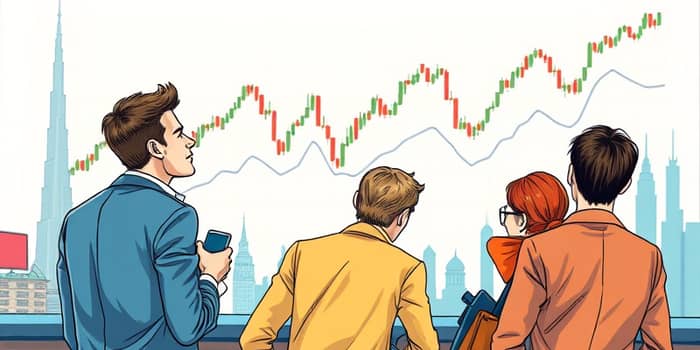
In the midst of a global market swirling with conflicting signals, investors are treading carefully. After months of choppy trading, mixed economic readings have left many market participants uncertain. While some data points point toward improvement, others highlight lingering challenges. This article explores the latest sentiment trends, examines key June 2025 figures, delves into the main drivers behind continued caution, and offers practical strategies for navigating the road ahead.
Throughout June, the mood on trading floors and in boardrooms was dominated by doubt. According to Jefferies’ business jet broker survey, sentiment in June registered a modest uptick at 6.1 out of 10, up from 5.9 in January, yet still far below the January 2022 peak of 8.7. Meanwhile, the S&P Global Investment Manager Index’s Risk Appetite gauge rose to –13% in June from –19% in May, marking the fifth straight month where risk aversion has prevailed.
Individual and institutional approaches to risk remain divergent. Over half of individual investors are holding their current portfolio allocations, and only 28% expect a drop of more than 10% in the next six months. Institutional players, by contrast, have only cautiously increased equity exposures following the temporary tariff relief. This split underscores a market grappling with conflicting signals—some hopeful, others wary.
June brought a mixture of encouraging and discouraging data. The University of Michigan’s Consumer Sentiment Index rebounded to 60.7 in June after six consecutive months of decline, though it remains 18% below its December 2024 level. Retail sales in May fell by 0.9%, driven largely by weakness in auto purchases. On the policy front, the Federal Reserve held its benchmark rate steady for the fourth straight meeting, while futures markets still price in two rate cuts later this year.
Investors are confronting a host of headwinds. First, persistent risk aversion across markets continues to shape decision-making, even as volatility eased slightly after a turbulent April. Inflation remains elevated, with year-ahead expectations at 5.1% in June, down from 6.6% in May, but still high relative to pre-pandemic norms. Real wage growth has stagnated, leaving many consumers feeling the squeeze despite tariff relief.
Trade policy remains opaque. The temporary 90-day tariff pause on US–China goods provided temporary relief from tariff pause concerns, yet the outlook beyond August is uncertain. Geopolitical flashpoints in the Middle East and ongoing fiscal negotiations in Washington add to the complexity. Moody’s downgrade of US credit in mid-May served as a stark reminder that fiscal constraints could pose further risks to investor confidence.
Sector performance is similarly bifurcated. Technology and consumer discretionary names, led by the so-called “Magnificent Seven,” have driven recent gains, while retail sales data and the NAHB housing index underscore continued weakness in consumption and real estate. Bond markets show a preference for high-quality investment-grade debt, while high-yield areas remain under pressure.
April’s sharp correction, sparked by trade tensions and erratic volatility, gave way to a partial rebound in May and June as tariffs were paused. Yet equity market gains have been modest, with the S&P 500 roughly flat year-to-date. Investors have favored high-quality stocks, defensive sectors like utilities, and short-duration bonds.
rebound in US consumer sentiment offered a tactical window for risk-taking, but most institutional investors have opted for measured exposure. Portfolio managers are focusing on balancing growth exposure with downside protection, using selective stock picks and hedging strategies rather than broad-based risk-on positions. Individual investors, meanwhile, remain remarkably steady, with fewer than one in four reducing allocations due to fears of a steep correction.
Looking ahead, several catalysts will shape the trajectory of markets in the second half of the year. Trade negotiations between the US and China, fiscal deal-making in Congress, and the timing of Fed rate cuts all represent potential inflection points. A sustained drop in inflation expectations, combined with firm wage growth, could pave the way for a more confident risk environment.
In a climate of mixed signals, maintaining discipline and perspective is paramount. Investors can consider the following approaches to navigate uncertainty:
Investor sentiment in mid-2025 reflects a market at a crossroads. While pockets of optimism have emerged, persisting macro uncertainties and uneven data keep many on edge. Success in this environment requires a careful balance of opportunity and caution, blending selective risk-taking with robust downside protections. By staying informed, flexible, and grounded in long-term objectives, investors can position themselves to thrive even amid ongoing volatility.
References













